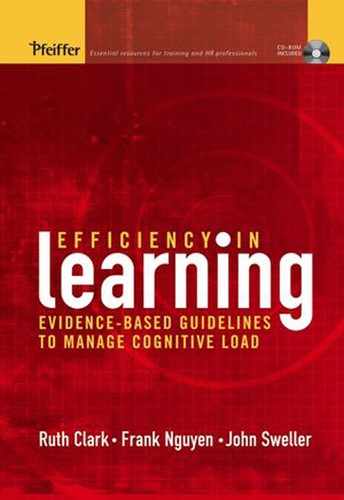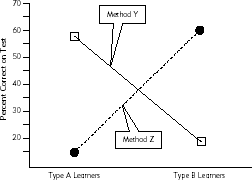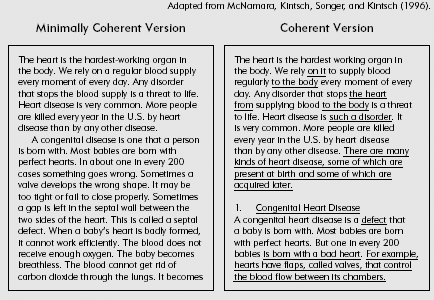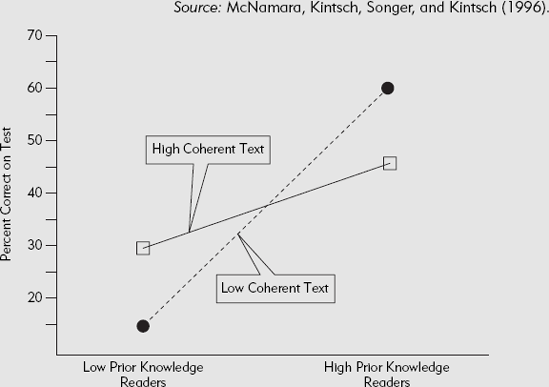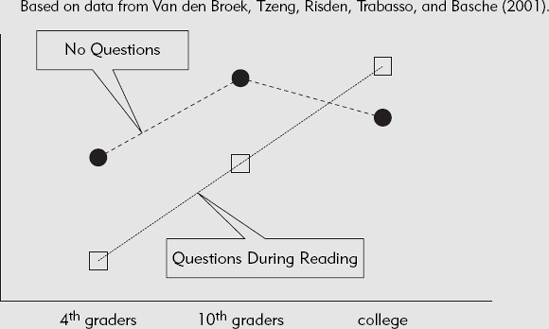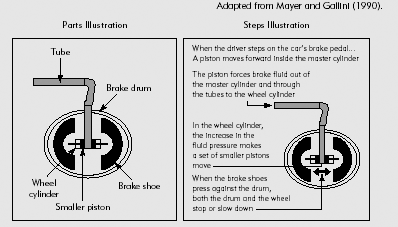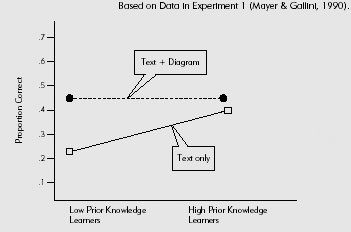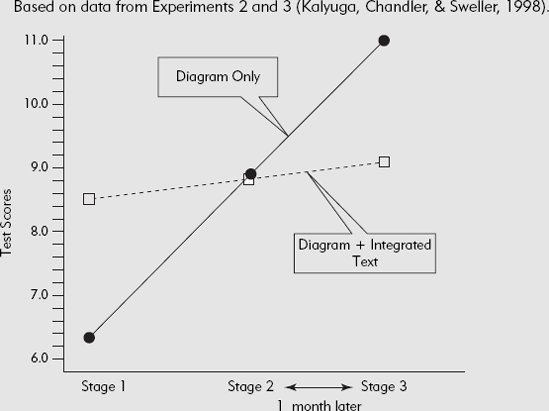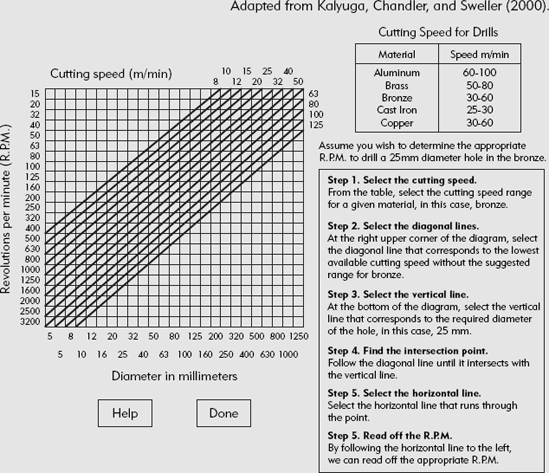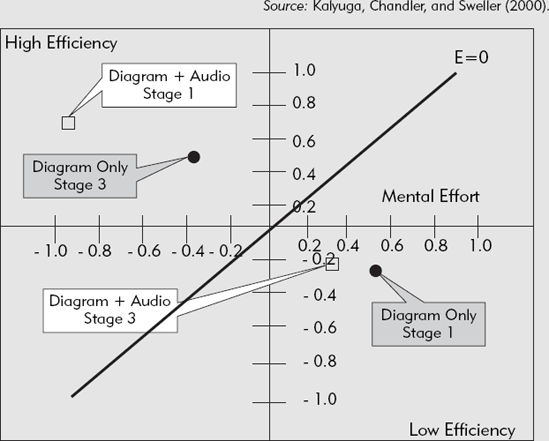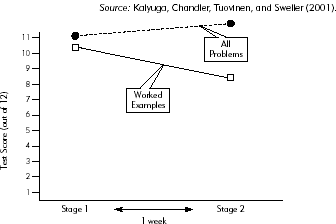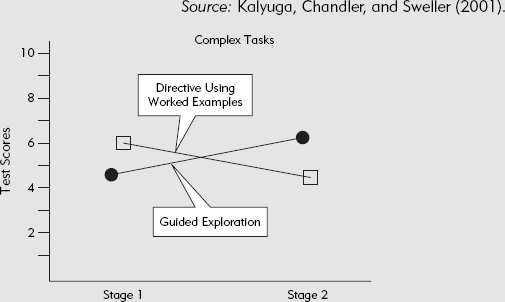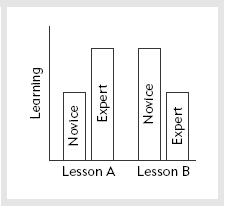
Learning styles are one type of unproductive instructional mythology pervasive in the training profession. At best, most learning style programs are a waste of resources, and at worst, they lead to instructional methods that actually retard learning. A good example is the popular idea that there are visual learning styles and verbal learning styles. According to this myth, some people learn more from their visual senses, while others learn more from their auditory senses. In a misguided attempt to accommodate visual and auditory styles, many e-learning courses present content using visuals, text to describe the visuals, and audio narration of that text. However, as we have seen in Chapter 5, presenting words simultaneously in text and in audio results in a psychological redundancy that overloads working memory and depresses learning.
The concept of learning styles is based on an assumption of individual differences among learners that reliably interact with different types of instruction. For example, according to the visual-auditory learning style myth, an individual with a visual learning style will learn more from a visual presentation than from an auditory presentation, whereas an individual with an auditory learning style shows the reverse pattern.
Any consistent response to a specific instructional method by a group of learners that share a common attribute results in what instructional scientists call an interaction. We've touched on interactions in previous chapters, but since this entire chapter is about interactions, it's an opportune time to take a closer look.
An interaction means that individuals of Type A will have a better or worse learning outcome with a given instructional Method Z than will individuals of Type B. When two instructional methods have opposite effects on two different types of learners, the result is called a disordinal interaction. A disordinal interaction exists, for example, when Type A individuals learn more from Method Y than from Method Z and, at the same time, Type B individuals learn more from Method Z than from Method Y. Figure 10.1 shows what a disordinal interaction looks like when the outcome data are plotted. As you can see, for learners of Type A, instructional Method Y resulted in much better learning than instructional Method Z. In contrast, Type B individuals show the reverse pattern. To maximize learning when you have this type of interaction, you would first determine whether any given learner was a Type A or a Type B and then tailor the instruction to match.
In order to adopt learning-style-based programs, we need replicated valid evidence (based on random assignment of learners to different instructional programs) showing that learners of Style A do better with one type of instructional approach, while learners of Style B do better with a different approach. We have not seen valid replicated evidence behind many of the popular learning styles, such as verbal and visual. However, prior knowledge is the one individual difference that has consistently been shown to interact with different instructional methods. Luckily, prior knowledge is an individual difference that is easier to assess than many other differences. In this chapter we will present guidelines, evidence, and psychology that show how you should adapt your instruction based on the amount of relevant prior knowledge possessed by your target learners.
Recall the experiments we summarized in Chapter 2 that compared expert and novice chess player memory for chess boards. Not surprisingly novices needed to refer back to a mid-play chess board more times than did experts in order to reconstruct it. Most interesting, however, was the reversal in this pattern when the chess board was a random board—one on which pieces did not reflect any real-world play patterns. When the board was random, expert memory was actually poorer than that of novices. This result is analogous to a pattern that Kalyuga, Ayres, Chandler, and Sweller (2003) term the expertise reversal effect.
As a novice chess player, your understanding of a mid-play and a random chess board are the same. Neither has any special meaning beyond a mix of game pieces placed on squares. However, as you gain expertise, your understanding of play patterns makes viewing a random board disruptive. Applied to training, expertise reversal predicts that a given instructional method that works well for novice learners is not only not useful for individuals with more expertise, but also results in depressed learning outcomes! In other words, in expertise reversal you will see an interaction between instructional method A that is effective for novices and instructional method B that is effective for experts.
The reason that expert chess players don't do well remembering random chess boards is that they view chess boards through eyes that are trained to look for meaningful patterns. These patterns are based on schemas that experts have built in their long-term memory over many chess games. When faced with a real mid-play chess board, these schemas allow experts to represent several pieces as one large item of information in working memory. A consequence of interpreting the world through schemas is a larger virtual working memory capacity for incoming information. However, when those familiar patterns disappear, as in a random chess board, expert performance is degraded due to the resources diverted to resolving the conflict between their schemas and the environment.
Throughout this book we have presented a number of evidence-based instructional methods that manage cognitive load. These methods are effective because they serve as schema substitutes for novice learners. Since novices don't have relevant schemas, the instruction needs to serve the role that schemas in long-term memory would serve. The instructional methods that serve as schema replacements for novices are not needed by experts and consequently are redundant.
Recall from Chapter 5 that a self-explanatory diagram should not be re-explained with words. Adding redundant explanatory information only burdens working memory with unneeded data and consequently depresses learning. As an individual gains expertise, he builds many relevant schemas applicable to further learning in his area of expertise. Therefore most of the instructional methods we have described throughout this book become redundant for learners with relevant knowledge in the instructional domain. In short, just about all of the guidelines we have presented in previous chapters apply to novice learners. Once learners have gained relevant prior knowledge, you need to readjust your instructional methods.
As a consequence of expertise reversal, efficient instruction for more advanced learners will require different methods than training designed for entry-level learners. If your training is extensive and supports a transition from low to high proficiency, you will need to adjust your more advanced lessons to accommodate the greater experience of your learners. A typical example is new hire training. Many new hire training programs extend over a number of weeks and combine formal training with on-the-job experience. During this process, trainees who started as complete novices build skills reaching relatively high levels of proficiency by the end of the training. In an ideal situation, the initial lessons that the new trainees study apply most of the load management guidelines we have suggested throughout this book. However, as learning progresses, the instructional materials transition to different methods that we summarize in this chapter.
If you are delivering instruction by self-paced e-learning, you can take advantage of a newly discovered efficient testing method to quickly assess the expertise of each learner as she progresses in the training. Applying this method results in an ongoing dynamic evaluation of learning accompanied by the assignment of the best instructional methods for a given level of expertise. We will provide more details of this method in the next chapter.
Throughout this chapter we will summarize evidence for the expertise reversal effect. The experiments we describe use one of two approaches that we call comparison group and staged.
Most of the research we have discussed throughout the book uses a comparison group design in which learning from one lesson version is compared with learning from an alternative version. In a comparison group experiment designed to test prior knowledge differences, two or more instructional versions are tested on a group of low prior knowledge learners and on a different group of high prior knowledge learners. For example, two lesson versions on the same topic are developed: one with text alone and one with diagrams and text. Then a group of high and low prior knowledge learners is divided in half and randomly assigned to one of the two lesson versions. All learners are tested at the end of the study period. This experimental plan yields four combinations:
Low prior knowledge learners studying the version with text alone;
Low prior knowledge learners studying the version with text plus diagram;
High prior knowledge learners studying the version with text alone; and
High prior knowledge learners studying the version with text plus diagram.
If the expertise reversal effect applies, you will see an interaction in which instructional methods that promote better learning among low prior knowledge learners are not as effective for high prior knowledge learners, and vice versa. When plotted on a graph, the results will look similar to Figure 10.1, in which Type A will be low prior knowledge and Type B will be high prior knowledge. This experimental design is frequently called a "cross-sectional" design because we use a cross section of lower and higher expertise learners, rather than observing the same learners as they gain expertise.
The other experimental design frequently used to study differences in expertise is called a staged design and is illustrated in Figure 10.2. In these studies, learning outcomes are compared in the same group over time as learning progresses. The experiment starts with all novice learners, who are randomly assigned to study either the text alone version or the text plus diagram version. After the initial study period, all learners are tested. Then the entire group completes a well-designed lesson to ensure that everyone has an equally effective opportunity to build expertise. After completing the well-designed training, Stage 2 begins. Stage 2 may immediately follow Stage 1 or may be scheduled at a later time, such as the following week. During Stage 2, the learners are again assigned to either the text alone version or the text plus diagram version. After a study period, learners are tested again. By Stage 2, learners have gained more expertise, and the experimental lesson versions (text alone or text with diagrams) might have a different effect on learning. This plan may be followed for several stages. Each stage would include a period of study of the experimental lesson materials plus a training period with well-designed materials to ensure that everyone gains expertise.
When the expertise reversal effect applies, the version that worked well for the learners in the early stages will not work as well for them as they gain expertise and eventually will result in less learning than the comparison versions. When the data is plotted on a graph, the pattern will look similar to that shown in Figure 10.1, with Type A learners replaced with Stage 1 and Type B learners replaced with Stage 2. This experimental design is frequently called a "longitudinal" design because we use the same learners whose expertise alters over time, rather than a cross section of learners with different levels of expertise.
In either the comparison group or the staged approach, if the learners rate the difficulty of the experimental instructional materials at the end of their study period, an efficiency metric can be calculated. These metrics can be plotted on the efficiency graph, as we discussed in Chapter 1. The main difference you will see on these efficiency graphs is two data points for each test lesson: one set of data points representing efficiencies for low knowledge learners and one set representing efficiencies for high knowledge learners.
In this chapter we provide evidence-based guidelines for instructional methods that work best with low knowledge learners and with high knowledge learners. We summarize what is known about individual differences regarding learning from text alone, text with and without diagrams, worked examples and problem assignments, as well as directive and guided discovery course designs.
This first guideline might sound odd, since this is a chapter about instructional methods for learners with high knowledge. However, we have evidence that you will get a return on investing resources in making texts very clear for novices—but not for readers with relevant experience.
Here we see an example of the expertise reversal effect. A high coherence text that most effectively helped low prior knowledge learners understand its meaning exerted the opposite effect on high prior knowledge readers. High prior knowledge readers learned more from a low coherent text. An explanation for this result based on cognitive load theory is that high prior knowledge readers already have adequate schemas about heart functions. Adding schema support in the form of extra explanations and preview sentences was redundant for high prior knowledge readers. The load added to their working memory had a negative overall impact on their processing of the text. In contrast, because low prior knowledge readers lacked appropriate schemas, they experienced additional extraneous cognitive load when reading the less coherent text.
We need more research on text coherence before we recommend writing low coherent texts for more experienced learners. We can say that adding explanations that are unnecessary for a given level of readership should, according to cognitive load theory, have negative effects, as found by McNamara, Kintsch, Songer, and Kintsch (1996). We do recommend that extra investment be made to prepare highly coherent instructional texts for novice learners. From a cognitive load perspective, reading difficulty was not rated, so we do not know whether the outcome observed in this study reflects a redundancy effect. We look forward to more research for evidence-based writing guidelines to guide our writing practices for high and low knowledge readers.
While we are on the topic of learning from reading, we briefly mention research showing that it's not a good idea to ask poor readers to answer questions about what they read while they are reading. That's because individuals with weak reading skills need to invest all of their cognitive effort in processing the text. To ask them to respond to questions at the same time leads to cognitive overload and less learning.
While most organizational training professionals are not creating materials for fourth graders, in a global economy many learners may not be native speakers of English. In addition many trainees may have low reading proficiencies. Based on this evidence, we recommend that, when designing written materials for lower skilled readers, you should avoid inserting questions into the materials. Instead you can promote understanding by providing opportunities for questions and discussion after completing the reading assignment.
The research supporting Guidelines 25 and 26 tells us that:
You should write considerate text for readers unfamiliar with the content.
Considerate text includes guidance such as
Organizing sentences or diagrams that preview or review the content
Definitions and examples of unfamiliar terms
Explicit statement that require minimal inferences
Headers to signal paragraph topics
You need not invest as much effort in writing considerate text for readers familiar with the topic for whom it may be redundant.
You are likely to decrease comprehension of low skilled readers by interrupting their reading with questions.
You can improve comprehension of high skilled readers by including questions with their reading assignments.
In Chapter 3, we saw that relevant diagrams help learners to perform procedural tasks more effectively than text, as well as promote a deeper understanding of content. Further, we recommended that you explain visuals with audio narration. However, when a diagram is self-explanatory, it becomes redundant to add words in any form, as we discussed in Chapter 5. In this section we review guidelines showing that more experienced learners will profit as well as or better from either text or diagrams alone. Experienced learners will not need the redundant information contained in the combination of text and diagram. In fact, it is likely that such redundant information will depress their learning.
In a summary of several experiments comparing effects of diagrams on high and low knowledge learners, Mayer (2001) reports that low prior knowledge learners studying texts with relevant diagrams will on average show performance gains 61 percent greater than performance gains of high prior knowledge readers. As with the reading studies summarized under Guideline 25, the data suggest that we invest more resources in design of effective materials for low prior knowledge than for high prior knowledge learners. First, we should pay attention to the coherence of the written text and, second, we should add relevant diagrams to illustrate the ideas in the text.
Note, however, that the expertise reversal effect was not seen in the Mayer and Gallini (1990) study. Learning of high prior knowledge learners was the same from versions with text alone as from versions with text and graphics. Mayer and Gallini did not specifically seek out high and low knowledge individuals. Rather, they took a group of individuals and divided them into higher and lower knowledge groups. By increasing the knowledge base of the high knowledge group, the probability of a full expertise reversal effect is increased.
The experiments of Mayer and Gallini (1990) and Kalyuga, Chandler, and Sweller (1998, 2000) evaluated different combinations of text and diagrams. None of them compared three conditions of text alone, text plus diagram, and diagram alone. Until we have data from such a comparison, we recommend that when the text alone is self-explanatory, it is more cost-effective to eliminate diagrams in lessons designed for more experienced learners. In contrast, if the diagram is essential to the task, drop the text. For example, interpreting cutting speed from a diagram like the one shown in Figure 10.9 cannot be done without the diagram. When the visual information is essential to performing the task, you will need to delete the text for more experienced learners familiar with the diagram. In contrast, when the visual information is not an integral part of the task, drop the diagrams in lieu of the text.
In Chapter 8, we presented a number of guidelines on how to best sequence and structure faded worked examples in order to gradually impose mental work on learners. Therefore here we will only briefly review how worked examples interact with learners of low and high prior knowledge.
Kalyuga, Chandler, Tuovinen, and Sweller (2001) compared the learning benefits of lessons with worked example-problem pairs to lessons with all-problem assignments for training how to write programs for relay circuits of various levels of complexity. Experiment 1 used a staged learning approach. They found that worked example-problem pairs led to greater learning than all-problem lessons for the first two stages. However, by Stage 3, the learning effects of the two lesson versions were equivalent. An expertise reversal effect had not yet occurred. The research team concluded that an expertise reversal would take place if the learners had even more experience with this type of programming. Because they had limited time to work with the participants, they conducted a second experiment using an easier task that could be learned faster. This experiment involved two stages. As you can see in Figure 10.11, sufficient expertise was gained by the learners so that by Stage 2 worked examples became redundant and learning was better with all practice problems.
The research on worked examples and expertise recommends that you should:
Provide fully worked examples for novice learners.
Convert fully worked examples to completion examples that fade instructional support by requiring learners to fill in greater portions of the examples.
End the sequence with a full practice assignment.
Vary the cover story of the examples and practice when far transfer outcomes are desired.
Based on cognitive load theory, once learners have formed their own schemas for performing a task, they are better off solving problems based on those schemas. Having to study worked examples of a task they already know adds an unnecessary and sometimes conflicting repetition, which adds load to working memory. The consequence is depressed learning.
Recall from Chapter 7 that a directive lesson presents guidelines or steps, shows worked examples of how to apply the guidelines or steps, and then asks the learner to practice through faded worked examples and/or practice problems. For example, in our sample spreadsheet e-lessons on the CD, we initially explain rules for formatting Excel formulas followed by faded worked examples and then practice assignments.
In contrast, lessons with a discovery or guided discovery design use a more inductive approach. Inductive lessons provide learners with stories, experiences, or exploratory opportunities from which learners are expected to derive the relevant guidelines or steps. For example, at one point in our Excel virtual classroom lesson, the instructor showed three sample formulas and asked learners to derive the major formatting rules.
Various types of guided discovery course architectures are frequently touted as better because the learner is constantly engaged. However, engagement not directed toward schema acquisition and automation can impose an extraneous working memory load. Next, we review two experiments that compared learning from a directive lesson in which worked examples were provided with learning from guided discovery lessons in which learners were asked to provide their own examples.
The research on directive versus guided discovery lesson designs suggests that you:
Prepare directive lessons for novice learners that provide brief content segments that include explanations, examples, and practice.
Prepare directive lessons when it is important to save training time.
Prepare either directive or guided discovery lessons for more experienced learners.
There are solid research and psychological reasons for recommending that you:
Adapt instructional methods based on individual differences in prior knowledge.
You may need to adjust methods within a lengthy training period as learners gain expertise.
In e-learning you can dynamically adapt training to differences in expertise, as described next in Chapter 11.
Invest effort in writing considerate text for readers unfamiliar with the topic.
Include questions during reading for skilled readers but not for unskilled readers such as English as a second language students.
Include relevant diagrams and text for novice learners.
Drop either the diagram or the text for experienced learners.
Drop the text if the diagram is required to complete the task.
Drop the diagram if the diagram is not essential to task completion.
Start with worked examples and transition to full practice exercises via completion examples as learners gain expertise.
Use directive architectures that provide steps, examples, and practice for novice learners.
Chapter 10: Accommodating Differences in Learner Expertise. John discusses the types of individual differences that are proven to make a difference to learning, followed by specific discussion of expertise reversal.
In this chapter we have recommended that you adapt your instruction according to the expertise of your learner. In e-learning, individual measures of learner knowledge can be used as the basis for adapting instructional methods dynamically as each learner progresses through the instruction. Adaptive testing has not been used extensively, however, because it is time-consuming for learners to take tests throughout the training. However, Kalyuga and Sweller (2004) have reported a brand new method of rapid testing that makes tailored instruction in e-learning practical. We summarize their research in Chapter 11.
